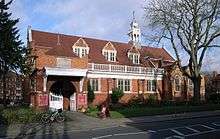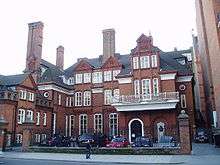Richard Norman Shaw

Richard Norman Shaw RA (7 May 1831 – 17 November 1912), sometimes known as Norman Shaw, was a Scottish architect who worked from the 1870s to the 1900s, known for his country houses and for commercial buildings.
Life
Shaw was born in Edinburgh,[1] and trained in the London office of William Burn with George Edmund Street. Shaw attended the Royal Academy classes and received a grounding in classicism. There, he met William Eden Nesfield, with whom he briefly partnered in some architectural designs. In 1854–1856 Shaw travelled with a Royal Academy scholarship, collecting sketches that were published as Architectural Sketches from the Continent, 1858. [2]
In 1863, after sixteen years of training, Shaw opened a practice for a short time with Nesfield. In 1872, he was elected an Associate of the Royal Academy. [2]
Shaw worked, among others, for the artists John Callcott Horsley and George Henry Boughton, and the industrialist Lord Armstrong. He designed large houses such as Cragside, Grim's Dyke, and Chigwell Hall, as well as a series of commercial buildings using a wide range of styles.[2]
Shaw was elected to the Royal Academy in 1877,[2] and co-edited (with Sir Thomas Jackson RA) the 1892 collection of essays, Architecture, a profession or an Art?.[3] He firmly believed it was an art. In later years, Shaw moved to a heavier classical style which influenced the emerging Edwardian Classicism of the early 20th century. Shaw died in London, where he had designed residential buildings in areas such as Pont Street, and public buildings such as New Scotland Yard.
Shaw's early country houses avoided Neo-Gothic and the academic styles, reviving vernacular materials like half timber and hanging tiles, with projecting gables and tall massive chimneys with "inglenooks" for warm seating. Shaw's houses soon attracted the misnomer the "Queen Anne style". As his skills developed, he dropped some of the mannered detailing, his buildings gained in dignity, and acquired an air of serenity and a quiet homely charm which were less conspicuous in his earlier works; half timber construction was more sparingly used, and finally disappeared entirely. [2]
Built work
| Place | Location | County | Date | Listed | [hide]Notes |
| Greenham Lodge | Berkshire | ||||
| Holme Grange School | Wokingham | Berkshire | 1883 | ||
| Highdown School | Emmer Green, Reading | Berkshire | 1878–80 | ||
| Dawpool | Cheshire | demolished, 1927 | |||
| All Saints’ Church, Youlgreave | Youlgreave | Derbyshire | 1869 - 1870 | restoration | |
| St Giles' Church | Longstone | Derbyshire | 1872-73 | restoration | |
| Flete House | Devonshire | ||||
| House of Bethany | St. Clement's Road, Bournemouth | Dorset | 1874–75 | ||
| Bryanston School | Dorset | 1898 | |||
| Bannow | Residential Care Home, St Leonards-on-Sea | East Sussex | 1877 | ||
| Baldslow Place | St Leonards-on-Sea | East Sussex | 1888 | originally the Ebden family home, now Claremont School | |
| Chigwell Hall | Chigwell | Essex | 1876 | The building is now owned by the Metropolitan Police | |
| Flora Fountain | Mumbai | India | 1864 | ||
| Alcroft Grange | Tyler Hill, Canterbury | Kent | 1880s[4] | Now divided into 4 wings[5] | |
| Swanscombe Church | Kent | ||||
| 4 – 6 Page Heath Lane | Bickley | Kent | 1864 | ||
| The Corner House | 114 Shortlands Road, Beckenham | Kent | 1869 | ||
| Bailiff's Cottage | Bromley Palace Estate, Bromley | Kent | 1864 | demolished | |
| Town Hall | Market Square, Bromley | Kent | 1863 | unexecuted | |
| Albion House | James Street | Liverpool | 1896–98 | ||
| 1–2 St. James Street | London | 1882–83[6] | |||
| Grim's Dyke | Harrow | London | 1870 | II[7] | |
| New Zealand Chambers | Leadenhall Street | London | 1871–73[6] | ||
| Lowther Lodge | Kensington | London | 1873–75 | headquarters of the Royal Geographical Society | |
| 6 Ellerdale Road | Hampstead | London | built for himself | ||
| 8 Melbury Road | Kensington | London | 1872–73[8] | built for painter Marcus Stone | |
| Woodland House | 31 Melbury Road, Kensington | London | 1876–77[8] | built for painter Luke Fildes | |
| Swan House | 17 Chelsea Embankment | London | 1875–77 | ||
| Ellern Mede | 31 Totteridge Common, Barnet | London | 1877 | ||
| Bedford Park | London | 1879–82 | the first "garden city" suburban development: housing, including St. Michael and All Angels Church | ||
| Albert Hall Mansions | Kensington Gore | London | 1879–86 | ||
| Tabard Hotel | Chiswick | London | |||
| Norman Shaw Buildings | Thames Embankment | London | 1887–1906 | Originally built as the new headquarters of the Metropolitan Police, and the first location to be known as New Scotland Yard. The two buildings are now used as Parliamentary offices. | |
| Kate Greenaway House | Frognal | London | 1885 | ||
| 1 St. James's Street | London | 1904 | |||
| Trevanion | Totteridge Lane, Barnet | London | 1883–84 | ||
| Piccadilly Hotel | Piccadilly Circus | London | 1905–08 | his last work | |
| Gatehouse to Banqueting Hall | Jesmond Dene | Newcastle upon Tyne | 1869-1870 | ||
| Cragside | Rothbury | Northumberland | 1869/1870–1885 | ||
| Chesters | Northumberland | ||||
| Preen Manor | Shropshire | ||||
| Adcote | Little Ness | Shropshire | 1876–81 | ||
| Knight's Bank | Farnham | Surrey | 1868 | demolished 1932 | |
| Pierrepont and Merrist Wood | Surrey | ||||
| Pierrepont House | Frensham | Surrey | 1876–78 | ||
| Alderbrook Park | Cranleigh | Surrey | 1881 | demolished 1956 - house for Pandeli Ralli | |
| Leyswood | Withyham | Sussex | 1866–69 | ||
| Bannow | St. Leonard's | Sussex | 1877–79 | private house, now nursing home | |
| Withyham | Sussex | 1867 | |||
| Gorehill | Petworth | West Sussex | 1871 | ||
| Old School House | Hammerwood, Nr East Grinstead | West Sussex | 1872 | formerly the village school | |
| Wispers | West Sussex | 1874–76 | |||
| White Lodge and White Lodge West | Bingley | West Yorkshire | |||
| Bradford City Hall extension | Yorkshire | 1909 | |||
| Holy Trinity Church | Bingley | Yorkshire | 1866–68 | demolished 1974 |
Gallery
 Cragside, Northumberland
Cragside, Northumberland St. Michael and All Angels, Bedford Park
St. Michael and All Angels, Bedford Park Norman Shaw Buildings, London
Norman Shaw Buildings, London Lowther Lodge, headquarters of the Royal Geographical Society
Lowther Lodge, headquarters of the Royal Geographical Society- Adcote, Shropshire
- Grim's Dyke, Harrow, London
 Chigwell Hall, Essex
Chigwell Hall, Essex 1–2 St. James Street, London, 1882–83
1–2 St. James Street, London, 1882–83 House for Kate Greenaway in Frognal, 1885
House for Kate Greenaway in Frognal, 1885
See also
References
- ↑ "Shaw, Richard Norman". Who's Who. Vol. 59. 1907. p. 1591.
- 1 2 3 4 5 Chisholm 1911.
- ↑ Richard Norman Shaw, editor: Architecture: A profession or an art: thirteen short essays on the qualifications and training of architects, London, Murray, 1892. Contributors include: R. Norman Shaw, J. T. Micklethwaite, Reginald Blomfield, G.F. Bodley, Mervyn Macartney, Ernest Newton, Edward S. Prior, John R. Clayton, Basil Champneys, W.R. Lethaby, W.B. Richmond, Gerald Horsley and T.G. Jackson.
- ↑ John Martin. "Y900003 / Youth Hostels Association (England and Wales) / Historical listing of all youth hostels and associated accommodation" (PDF). Retrieved 22 November 2016.
- ↑ "Check out this property for sale on Rightmove!". Rightmove.co.uk. Retrieved 2017-06-05.
- 1 2 John Bold; Tanis Hinchcliffe; Scott Forrester (27 January 2009). Discovering London's Buildings: With Twelve Walks. frances lincoln ltd. pp. 105–. ISBN 978-0-7112-2918-1. Retrieved 1 July 2012.
- ↑ "GRIMSDYKE, Harrow - 1079676| Historic England". www.historicengland.org.uk. Retrieved 2017-06-05.
- 1 2 "Survey of London: volume 37: Northern Kensington". British History Online. Retrieved 28 June 2012.
- Attribution
-
 This article incorporates text from a publication now in the public domain: Chisholm, Hugh, ed. (1911). "Shaw, Richard Norman". Encyclopædia Britannica (11th ed.). Cambridge University Press.
This article incorporates text from a publication now in the public domain: Chisholm, Hugh, ed. (1911). "Shaw, Richard Norman". Encyclopædia Britannica (11th ed.). Cambridge University Press.
Sources
- Andrew Saint, Richard Norman Shaw, revised edition, 2010. ISBN 978-0-300-15526-6.
External links
| Wikimedia Commons has media related to Richard Norman Shaw. |
- Great Buildings on-line: Richard Norman Shaw
- Illustrations of Adcote
- Flickr photoset
- Archiseek: Richard Norman Shaw